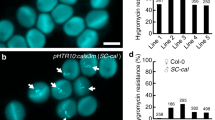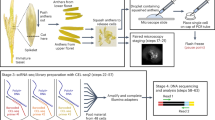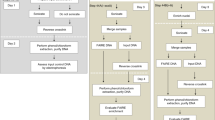Abstract
Research investigating the dynamics of male gametophyte (MG) development has proven to be challenging for the plant science community. Here we describe our protocol for separating Arabidopsis MG developmental stages, which is based on the centrifugation of pollen through a discontinuous Percoll concentration gradient. This Percoll gradient can be formed using a pipette, and it does not require a gradient maker. The purity of the isolated developing spores is as high as 70%, and in most separations it is well above 80%. Using this protocol, we can separate four different stages of pollen development—uninucleate microspore (UNM), bicellular pollen (BCP), tricellular immature pollen (TCP) and mature pollen grain (MPG). The duration of the separation procedure, excluding the cutting of flower inflorescences, is 6 h. This is reduced to 4 h when using a vacuum cleaning method to remove the MPGs before the Percoll density separation.
This is a preview of subscription content, access via your institution
Access options
Subscribe to this journal
Receive 12 print issues and online access
$259.00 per year
only $21.58 per issue
Buy this article
- Purchase on Springer Link
- Instant access to full article PDF
Prices may be subject to local taxes which are calculated during checkout







Similar content being viewed by others
References
Honys, D. & Twell, D. Comparative analysis of the Arabidopsis pollen transcriptome. Plant Physiol. 132, 640–652 (2003).
Honys, D. & Twell, D. Transcriptome analysis of haploid male gametophyte development in Arabidopsis. Genome Biol. 5, R85 (2004).
Pina, C., Pinto, F., Feijo, J.A. & Becker, J.D. Gene family analysis of the Arabidopsis pollen transcriptome reveals biological implications for cell growth, division control, and gene expression regulation. Plant Physiol. 138, 744–756 (2005).
Becker, J.D., Boavida, L.C., Carneiro, J., Haury, M. & Feijo, J.A. Transcriptional profiling of Arabidopsis tissues reveals the unique characteristics of the pollen transcriptome. Plant Physiol. 133, 713–725 (2003).
Wang, Y. et al. Transcriptome analyses show changes in gene expression to accompany pollen germination and tube growth in Arabidopsis. Plant Physiol. 148, 1201–1211 (2008).
Borges, F. et al. Comparative transcriptomics of Arabidopsis sperm cells. Plant Physiol. 148, 1168–1181 (2008).
Mutz, K.O., Heilkenbrinker, A., Lonne, M., Walter, J.G. & Stahl, F. Transcriptome analysis using next-generation sequencing. Curr. Opin. Biotechnol. 24, 22–30 (2013).
Slotkin, R.K. et al. Epigenetic reprogramming and small RNA silencing of transposable elements in pollen. Cell 136, 461–472 (2009).
Loraine, A.E., McCormick, S., Estrada, A., Patel, K. & Qin, P. RNA-seq of Arabidopsis pollen uncovers novel transcription and alternative splicing. Plant Physiol. 162, 1092–1109 (2013).
Grant-Downton, R. et al. MicroRNA and tasiRNA diversity in mature pollen of Arabidopsis thaliana. BMC Genomics 10, 643 (2009).
Calarco, J.P. et al. Reprogramming of DNA methylation in pollen guides epigenetic inheritance via small RNA. Cell 151, 194–205 (2012).
Borges, F. et al. FACS-based purification of Arabidopsis microspores, sperm cells and vegetative nuclei. Plant Methods 8, 44 (2012).
Arcidiacono, A., Walt, H., Campana, A. & Balerna, M. The use of Percoll gradients for the preparation of subpopulations of human spermatozoa. Int. J. Androl. 6, 433–445 (1983).
Noguchi, M. et al. Centrifugation on Percoll density gradient enhances motility, membrane integrity and in vitro fertilizing ability of frozen-thawed boar sperm. Zygote 23, 68–75 (2015).
Pertoft, H. Fractionation of cells and subcellular particles with Percoll. J. Biochem. Biophys. Methods 44, 1–30 (2000).
Pertoft, H., Hiertenstein, M. & Kagedal, L. Cell separation in a new density gradient medium, Percoll. Methodological Surveys, Sub-series (B): Biochemistry Vol. 8 240 pp. (Ellis Horwood, Chichester, 1979).
Mateyko, G.M. & Kopac, M.J. Isopyknotic cushioning for density gradient centrifugation. Exp. Cell Res. 17, 524–526 (1959).
Lu, Y., Wei, L. & Wang, T. Methods to isolate a large amount of generative cells, sperm cells and vegetative nuclei from tomato pollen for 'omics' analysis. Front. Plant Sci. 6, 391 (2015).
Johnson-Brousseau, S.A. & McCormick, S. A compendium of methods useful for characterizing Arabidopsis pollen mutants and gametophytically-expressed genes. Plant J. 39, 761–775 (2004).
Mlejnek, P. & Prochazka, S. Activation of caspase-like proteases and induction of apoptosis by isopentenyladenosine in tobacco BY-2 cells. Planta 215, 158–166 (2002).
Schoft, V.K. et al. Function of the DEMETER DNA glycosylase in the Arabidopsis thaliana male gametophyte. Proc. Natl. Acad. Sci. USA 108, 8042–8047 (2011).
Smyth, D.R., Bowman, J.L. & Meyerowitz, E.M. Early flower development in Arabidopsis. Plant Cell 2, 755–767 (1990).
Park, S.K., Howden, R. & Twell, D. The Arabidopsis thaliana gametophytic mutation gemini pollen1 disrupts microspore polarity, division asymmetry and pollen cell fate. Development 125, 3789–3799 (1998).
Acknowledgements
We thank J. Fíla for his careful reading of the manuscript, J. Novotney for English editing and I. Jelínková for sowing and collection of plant material. N.D. thanks V. Čapková for her support. This work was supported by the Czech Science Foundation (grants 13-41444P to N.D. and P305/12/2611 to D.H.).
Author information
Authors and Affiliations
Contributions
N.D., D.R. and D.H. designed the protocol. N.D. performed the experiments. P.I.D. performed the HPLC/MS analysis. N.D. and D.H. wrote the manuscript.
Corresponding authors
Ethics declarations
Competing interests
The authors declare no competing financial interests.
Rights and permissions
About this article
Cite this article
Dupl'áková, N., Dobrev, P., Reňák, D. et al. Rapid separation of Arabidopsis male gametophyte developmental stages using a Percoll gradient. Nat Protoc 11, 1817–1832 (2016). https://doi.org/10.1038/nprot.2016.107
Published:
Issue Date:
DOI: https://doi.org/10.1038/nprot.2016.107
This article is cited by
-
Introducing Gamborg’s B5, a high-potential medium for isolated microspore culture, and presenting a new MS medium-based protocol for androgenic plant regeneration in eggplant (Solanum melongena L.)
Plant Cell, Tissue and Organ Culture (PCTOC) (2024)
-
Regulatory dynamics of gene expression in the developing male gametophyte of Arabidopsis
Plant Reproduction (2023)
-
Quantitative methods in microscopy to assess pollen viability in different plant taxa
Plant Reproduction (2020)
-
The effect of isolation methods of tomato pollen on the results of metabolic profiling
Metabolomics (2019)
-
Transcriptomics of Arabidopsis sperm cells at single-cell resolution
Plant Reproduction (2019)
Comments
By submitting a comment you agree to abide by our Terms and Community Guidelines. If you find something abusive or that does not comply with our terms or guidelines please flag it as inappropriate.



